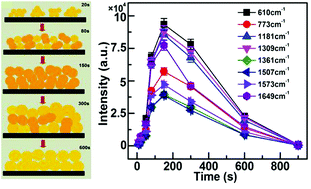Twinned copper nanoparticles modulated with electrochemical deposition for in situ SERS monitoring
Abstract
The earth-abundant copper nanoparticles were synthesized on glass carbon electrode as SERS substrate by electrochemical deposition method. Both deposition potential and time were used to modulate the microstructure and SERS activity of copper electrodeposits. The aggregation and evolution behaviors of the deposited copper nanoparticles were elucidated. An interesting dependence of SERS activity on the obtained copper deposits was observed. When deposition potential becomes more negative, the SERS activity of the copper deposits obtained at 150 s diminishes gradually until it reaches to a minimum value at −0.8 V, and then dramatically strengthens again. However, the SERS activity of copper deposits obtained at −0.9 V rapidly is enhanced as deposition time increases and reaches to a maximum value at about 150 s, then gradually weakens and even vanishes at 900 s. The SERS performance of Cu nanoparticles depends on their grain size and the intergranular gaps, which are able to offer “hot spots” for Raman enhancement. Especially, the formed peanut-like Cu nanoparticles are advantageous for the reliable and reproducible SERS detection. Owing to their good SERS activity and potential catalytic property, the copper deposits are successfully employed to in situ monitoring of the electrocatalytic reduction process of nitrate.



 Please wait while we load your content...
Please wait while we load your content...